#japanese phonology
Explore tagged Tumblr posts
Text
Gonna drop the most nitpicky linguistic criticism of JWCT known to man in a few days. In unrelated matters anyone on JWCC/T tumblr a native Japanese speaker
#jwct#chaos theory#jwct spoilers#like. Daniel’s Japanese needs some work from what I can tell but again I don’t even speak the language just know about its phonology
20 notes
·
View notes
Text
remembers a reddit comment thread where someone said that っ basically works as a glottal stop. and sighs.
#leologisms#actually go and watch native speakers speaking for any amount of time and youd see that its just. completely untrue#like yeah man japanese phonology is transcribed with a special /Q/ mora for fun and not because the mora changes realisation drastically#in different contexts. yeah man actually it really is just /ʔ/ and linguists are just fucking with you. yeah man#dont worry about the fact that if you watch native speakers talking you can literally SEE the succeeding consonant get geminated#and that if you tried to actually pronounce まったく as /maʔtaku/ youd find it both extremely awkward to produce AND extremely awkward#sounding. yeah man no it really is just /ʔ/. dont worry about it.#AS ALWAYS anything people say on reddit should never be taken seriously but. pressure release valve. i get irritated
5 notes
·
View notes
Text
no no no no no i can feel myself being dragged into the special interest event horizon where i try to semi-realistically worldbuild/develop narutoverse japanese (specifically for the purposes of a scholomance crossover fic i probably won't ever finish where the elemental countries were basically shoved into a pocket dimension and closed off from the rest of the world in perhaps 1530 to get rid of the sage of the six paths) and i KNOW this is a huge mistake (don't go into the caves etc etc) but hhhhhhhhhhhhhh
like i'm already playing around with this concept that the hidden villages "feel" more modern than the rest of the naruto world and ESPECIALLY the non-ninja sengoku-flavored samurai social class and i think it would be cool if that extended to language (also something i'm playing with a LITTLE bit, because in my fics people from konoha tend to use honorifics in a modern way and i'm tryingggggg to figure out period-accurate honorifics to use in the daimyo's court but given that i Do Not Know How To Read Japanese this is really hard) BUT in the grand scheme of things the naruto world is still a small isolated society where you'd expect language change to not be very fast, and japanese has shifted a fuck of a lot in the irl world where we all live since the sengoku period, so i think it would be very fun if in the scholomance fic people from the naruto world talk 80% like they're in a stupidly well-researched period drama and 20% like they're speaking a different language
(ALSO IT MAY ALREADY BE TOO LATE FOR ME TO ESCAPE given the existence of my conlang notes on anbu sign language but shhhhh)
#the trashcan speaks#my fic#also does anyone have any resources about what common mistakes speakers of japanese as a first language make when learning english#like in addition to the obvious phonological stuff and confusion about articles#im assuming word order......?#ALSO also can i expect most upper-class people in a sengoku daimyo's social circle to know chinese or is that more of a heian thing#meta
4 notes
·
View notes
Text
I will say I'm not the best at foreign orthography but I am still shocked whenever someone very badly mispronounces a romanized Japanese word given that romanized Japanese is very common esp in online spaces and Japanese (Hepburn) romanization is incredibly straightforward and intuitive for English speakers
#logxx#Like Gavriel was giving me shit for not getting German orthography which I will grant is well made but not actually#Esp intuitive to English speakers. Esp because it involves a number of exceptions or changes in pronunciation#Based on position#The only time I can think of where Japanese romanization is inconsistent is the use of ou#Which is generally a long o sound rather than an o u (oh oo) sound#But other than that I mean. Hepburn is very good at intuitively communicating Japanese phonology to English speakers#And Japanese just doesn't have that many sounds. And rly only 2 sounds (initial ts and the tapped r) aren't present in English#The initial ts is pretty easy for Eng speakers to learn ime and the tapped r can be replaced w an l to sound almost the same
4 notes
·
View notes
Text
boop boop fall in love! kiboopkeba iboopdemo [the rest of sakura kiss here but with every u-row kana replaced with ‘boop’]
0 notes
Text
Naming International POC Characters: Do Your Research.
This post is part of a double feature for the same ask. First check out Mod Colette's answer to OP's original question at: A Careful Balance: Portraying a Black Character's Relationship with their Hair. Below are notes on character naming from Mod Rina.
~ ~ ~
@writingraccoon said:
My character is black in a dungeons and dragons-like fantasy world. His name is Kazuki Haile (pronounced hay-lee), and his mother is this world's equivalent of Japanese, which is where his first name is from, while his father is this world's equivalent of Ethiopian, which is where his last name is from. He looks much more like his father, and has hair type 4a. [...]
Hold on a sec.
Haile (pronounced hay-lee), [...] [H]is father is this world’s equivalent of Ethiopian, which is where his last name is from.
OP, where did you get this name? Behindthename.com, perhaps?

Note how it says, “Submitted names are contributed by users of this website. Check marks indicate the level to which a name has been verified.” Do you see any check marks, OP?
What language is this, by the way? If we only count official languages, Ethiopia has 5: Afar, Amharic, Oromo, Somali, & Tigrinya. If we count everything native to that region? Over 90 languages. And I haven't even mentioned the dormant/extinct ones. Do you know which language this name comes from? Have you determined Kazuki’s father’s ethnic group, religion, and language(s)? Do you know just how ethnically diverse Ethiopia is?
~ ~ ~
To All Looking for Character Names on the Internet:
Skip the name aggregators and baby name lists. They often do not cite their sources, even if they’re pulling from credible ones, and often copy each other.
If you still wish to use a name website, find a second source that isn’t a name website.
Find at least one real life individual, living or dead, who has this given name or surname. Try Wikipedia’s lists of notable individuals under "List of [ethnicity] people." You can even try searching Facebook! Pay attention to when these people were born for chronological accuracy/believability.
Make sure you know the language the name comes from, and the ethnicity/culture/religion it’s associated with.
Make sure you understand the naming practices of that culture—how many names, where they come from, name order, and other conventions.
Make sure you have the correct pronunciation of the name. Don’t always trust Wikipedia or American pronunciation guides on Youtube. Try to find a native speaker or language lesson source, or review the phonology & orthography and parse out the string one phoneme at a time.
Suggestions for web sources:
Wikipedia! Look for: “List of [language] [masculine/feminine] given names,” “List of most common [language] family names,” “List of most common surnames in [continent],” and "List of [ethnicity] people."
Census data! Harder to find due to language barriers & what governments make public, but these can really nail period accuracy. This may sound obvious, but look at the year of the character's birth, not the year your story takes place.
Forums and Reddit. No really. Multicultural couples and expats will often ask around for what to name their children. There’s also r/namenerds, where so many folks have shared names in their language that they now have “International Name Threads.” These are all great first-hand sources for name connotations—what’s trendy vs. old-fashioned, preppy vs. nerdy, or classic vs. overused vs. obscure.
~ ~ ~
Luckily for OP, I got very curious and did some research. More on Ethiopian & Eritrean naming, plus mixed/intercultural naming and my recommendations for this character, under the cut. It's really interesting, I promise!
Ethiopian and Eritrean Naming Practices
Haile (IPA: /həjlə/ roughly “hy-luh.” Both a & e are /ə/, a central “uh” sound) is a phrase meaning “power of” in Ge’ez, sometimes known as Classical Ethiopic, which is an extinct/dormant Semitic language that is now used as a liturgical language in Ethiopian churches (think of how Latin & Sanskrit are used today). So it's a religious name, and was likely popularized by the regnal name of the last emperor of Ethiopia, Haile Selassie (“Power of the Trinity”). Ironically, for these reasons it is about as nationalistically “Ethiopian” as a name can get.
Haile is one of the most common “surnames” ever in Ethiopia and Eritrea. Why was that in quotes? Because Ethiopians and Eritreans don’t have surnames. Historically, when they needed to distinguish themselves from others with the same given name, they affixed their father’s given name, and then sometimes their grandfather’s. In modern Ethiopia and Eritrea, their given name is followed by a parent’s (usually father’s) name. First-generation diaspora abroad may solidify this name into a legal “surname” which is then consistently passed down to subsequent generations.
Intercultural Marriages and Naming
This means that Kazuki’s parents will have to figure out if there will be a “surname” going forward, and who it applies to. Your easiest and most likely option is that Kazuki’s dad would have chosen to make his second name (Kazuki’s grandpa’s name) the legal “surname.” The mom would have taken this name upon marriage, and Kazuki would inherit it also. Either moving abroad or the circumstances of the intercultural marriage would have motivated this. Thus “Haile” would be grandpa’s name, and Kazuki wouldn’t be taking his “surname” from his dad. This prevents the mom & Kazuki from having different “surnames.” But you will have to understand and explain where the names came from and the decisions dad made to get there. Otherwise, this will ring culturally hollow and indicate a lack of research.
Typically intercultural parents try to
come up with a first name that is pronounceable in both languages,
go with a name that is the dominant language of where they live, or
compromise and pick one parent’s language, depending on the circumstances.
Option 1 and possibly 3 requires figuring out which language is the father’s first language. Unfortunately, because of the aforementioned national ubiquity of Haile, you will have to start from scratch here and figure out his ethnic group, religion (most are Ethiopian Orthodox and some Sunni Muslim), and language(s).
But then again, writing these characters knowledgeably and respectfully also requires figuring out that information anyway.
~ ~ ~
Names and naming practices are so, so diverse. Do research into the culture and language before picking a name, and never go with only one source.
~ Mod Rina
#asks#language#languages#linguistics#east africa#african#immigration#ethiopian#names#naming#research#resources#writeblr#character names#character name ideas#rina says read under the cut. read it
4K notes
·
View notes
Text




I just wanted to sing Our Light p5 correctly bro 😫
#persona 5#p5#our light#language#linguistics#japanese language#my discord#foreign languages#phonotactics#phonology
0 notes
Text
Fake-tanuki soup or Fake tanuki-soup?
連濁(れんだく; en: rendaku)is a phonological rule in japanese that makes the first voiceless consonant of a word change into a voiced consonant when used in a compound word. For example, おり + かみ → おりがみ (ori + kami → origami) ("fold" + "paper" → "paperfolding") - the /k/ sound in かみ becomes a /g/ sound (which is the voiced version of a /k/ sound) by adding a voicing mark -> が.
What’s interesting about 連濁 is that native speakers can use it subconsciously as a sort of “order of operations” system for unfamiliar words, like PEMDAS or BIDMAS in maths. A classic example of this is the にせたぬきじる problem[1]. Native speakers can immediately and with confidence tell the difference in meaning between two compound words they have never heard before, despite the only difference being the voicing of a single consonant. Take the three words 偽 (にせ, meaning “fake” or “imitation”), たぬき (tanuki, the Japanese racoon dog), and 汁 (しる, meaning “soup” or “broth”). They can be combined into the following compound words: にせたぬきじる and にせだぬきじる (note the voicing mark, or dakuten, on the latter). Keep in mind, these two words do not exist in ordinary japanese - they’ve been created as part of a linguistics experiment.
You might think the meaning would be ambiguous in those compound words: is it (imitation tanuki)+soup or imitation+(tanuki soup)? Let’s imagine we’re referring to the former. First, we combine にせ+たぬき. There’s a rule that rendaku can’t occur if there’s already a voicing mark in the second component of the compound, but we’re safe here - たぬき has no voicing mark. Therefore, it becomes にせだぬき. Then, we combine にせだぬき+しる. Again, しる has no voicing mark in it, so we’re safe to add it in, and we get にせだぬきじる.
Conversely, let’s say we were referring to fake “tanuki-soup”. First we combine たぬき+しる. This combines safely to たぬきじる. Then we combine にせ+たぬきじる. But wait, the second component does already have a voicing mark, on じ! So we can’t add one to た. Therefore we end up with にせたぬきじる.
That’s a lot of thinking and linguistic hoops to jump through to make up 2 words, but here’s the thing: Japanese native speakers who have never heard these words before can instinctively deduce the difference in meaning with startling accuracy. They correctly determine the meaning of にせだぬきじる as “a broth made from imitation tanuki” and にせたぬきじる as “a fake version of a dish called ‘tanuki soup’”. Even more surprising is the research findings of Shigeto Kawahara, which show that children as young as 9 years old can consistently deduce the difference as well[2]. I think this shows how incredibly powerful the subconscious mind is at learning linguistic rules, and how bad the conscious mind is at learning them!
#langblr#japanese#japanese language#language acquisition#language learning#language#linguistics#learning japanese#日本語#jimmy blogthong
717 notes
·
View notes
Text
I saw Starions coming in when I worked at Jiffy Lube. They had CD players which were an unheard-of luxury. I don't know what they were thinking bringing those cars in to a Jiffy Lube. Funnily enough, Starion ( スタリオン) is how the Japanese say stallion" ( スタリオン) in Japanese,

_1987_Mitsubishi_Starion
532 notes
·
View notes
Text
@raginrayguns You asked how measure words work in Japanese. Here is an explanation:
Measure words in Japanese do work somewhat differently than their Chinese counterparts. In Japanese they are not really independent words, and are better analyzed as suffixes that attach to numerals. Some measure words are commonly used as independent nouns (i.e. they can occur dislocated from a corresponding numeral, and behave syntactically/morphologically like ordinary Japanese nouns do), most prominently time words like 週間 shuukan "week", but many are either only used rarely as nouns or not at all. For instance, the measure word 枚 mai "sheets" does not occur as a noun. Measure words are phonologically bound to their preceding numerals, in the sense that
they form part of an intonational unit with the numeral, and
they often fuse with the numeral phonologically in irregular or semi-regular ways.
For instance, here are the numbers one through ten with a few common measure words:
Bare numerals:
一 二 三 四 五 ichi ni san yon go 六 七 八 九 十 roku nana hachi kyuu juu
Counting people (using 人 nin):
一人 二人 三人 四人 五人 hitori futari sannin yonin gonin 六人 七人 八人 九人 十人 rokunin nananin hachinin kyuunin juunin
Counting small animals (using 匹 hiki):
一匹 二匹 三匹 四匹 五匹 ippiki nihiki sanbiki yonhiki gohiki 六匹 七匹 八匹 九匹 十匹 roppiki nanahiki happiki kyuuhiki juppiki
Counting books/volumes (using 冊 satsu):
一冊 二冊 三冊 四冊 五冊 issatsu nisatsu sansatsu yonsatsu gosatsu 六冊 七冊 八冊 九冊 十冊 rokusatsu nanasatsu hassatsu kyuusatsu jussatsu
Counting machines (using 台 dai):
一台 二台 三台 四台 五台 ichidai nidai sandai yondai godai 六台 七台 八台 九台 十台 rokudai nanadai hachidai kyuudai juudai
Counting small objects:
一つ 二つ 三つ 四つ 五つ hitotsu futatsu mittsu yottsu itsutsu 六つ 七つ 八つ 九つ 十 muttsu nanatsu yattsu kokonotsu tō
There's a lot going on here. For one you have phonological interaction, as I mentioned. This is how you get ippiki from ichi + hiki, and so on. These rules are mostly regular within the large stratum of Chinese loan vocabulary in Japanese, but in the case of these measure words they are somewhat unpredictable. Importantly, these phonological phenomenon are not things you would get from just putting two independant words next to each other in Japanese; they occur only at morpheme boundaries within a single word.
Other than that you have suppletion, where morphemes from different sources are mixed and matched to create a full paradigm. For instance, hitori "one person" and futari "two people" are sourced from native Japonic numerals (as are the "small object" numerals in -tsu), whereas the other numerals for counting people (all in -nin) are sourced from borrowed Chinese numerals.
Due to all the above, the picture that emerges is that Japanese numeral + counter pairs are in fact individual words, sometimes composed transparently out of a numeral prefix and a counter suffix, and sometimes composed opaquely or irregularly. I think it's completely fair to say issatsu is "a special form of the word 'one' used for counting books" and so on. Now, I'll admit that I don't think this has much philosophical importance at all. For example, English dogs could be called "a special form of the word 'dog' used when there is a group of them", indeed this is precisely what a plural is. But that doesn't really tell you anything important; Japanese (mostly) lacks plurals and it gets on fine. Sometimes a language just has a rule that says "use this special word (or form of a word) in the particular circumstance".
Uh, for instance, Tok Pisin (an English-based creole of Papua New Guinea) has this particle i, used in expressions with a third-person subject:
mi bin tok 1sg PST speak "I spoke"
vs.
praim minista i bin tok prime minister 3 PST speak "the prime minister spoke"
Here "3" is just the standard gloss for a third-person morpheme, nothing to do with the numeral 3. "1sg" means "first-person singular" and "PST" means "past tense". Anyway, you might ask... what sort of word is i? It's not a pronoun, you can't (to my knowledge) say "i bin tok" on its own, you have to say
em i bin tok 3sg 3 PST speak "he spoke"
What does it correspond to in English translation? Well, it doesn't correspond to anything in English translation, it's just a little thingy that Tok Pisin grammar says you have to put there. Far from being remarkable this is wholly ordinary. I think Quine is making a lot of this fact when it really doesn't mean anything at all.
61 notes
·
View notes
Note
staring so kindly at your sluglang post,, as someone working on a language as well this looks fantastic (and is also. super organized compared to mine BHAHAH) Any tips for putting together a language? Like resources on how to go about it, or notes? /genq
You are staring kindly... (thank you)
As for tips... Wikipedia is actually one of my biggest, most useful tools, because I love to read articles about grammatical concepts, and they will usually have a varaiety of examples of use if you can figure out how to parse the academic language. There are some core ideas that pop up all over the place crosslinguistically, like case marking or converbs, and you can get a lot from learning how other languages might parse the same idea, both how they handle the idea grammatically and what kind of metaphorical language might be involved; like how in Scottish Gaelic, to say you have something, you say it's 'at' you, or how it doesn't have an exact equivalent of English's infinitive, or how Mongolian has so many word endings that convey meaning, and a bunch of them are literally endings stacked on top of other endings.
There's also really good conlang youtubers, like David Peterson, the one who made Dothraki and other pop media conlangs, Artifexian, Biblaridion. They have videos on both interesting grammatical concepts that don't exist in english AND how to integrate them into conlangs. Davide Peterson especially has interesting videos on things like sound changes, vowel harmony, phonological concepts that can really help shape your language and bring a degree of naturalism if that's what you're looking for.
Etymology can be extremely informative though, and really help you to understand exactly how creative people have gotten with language over the past thousands of years. Etymonline is a great website for that. Did you know that the word "next" was originally literally "nearest"? Or that that the suffix "be-" was originally "by", so words like "before" actually meant "by the fore", and very often these meanings are metaphorically extended to the way we use them today. It's great for helping to develop very important words that can be structural to your language, so that you're not just trying to raw make up a new word with no basis every time.
Aside from that, there's no single source I go to for making conlangs. Everything is on a case by case basis. Something that has been really helpful for me is constantly writing example sentences and finding things to write about, because similar to translating existing texts, it forces me to reckon with the way my conlang works, figure out how to convey certain ideas (or whether or not the language can convey the idea at all).
Usually I'll have a few languages that I keep in mind for inspiration for any given project and if I'm stumped or need an idea, I'll actually look up learning resources for those languages. My slugcat language has had me looking up a lot of "How to say..." in Korean, Arabic, Japanese Filipino, a little bit of Indonesian? Some Russian for verb stuff. Once I find resources, I spend a bit of time dissecting how it works in those languages and figure out how that can fit in the existing framework of my own project, or if it's something I'd even want in the project at all.
Once I have an idea, I'll just start iterating on it, usually on paper, basically brainstorming how the sentence structure and sounds might work until I find something that is both sonically satisfying and logically sound within the existing framework. If I'm feeling extra spicy, I might try to consider how the culture and priorities of the speakers might shape the development of the language. The important thing while doing this is, just like brainstorming, to be unafraid to keep throwing ideas onto the page no matter how unviable or nonsensical it may seem in your head. You NEED to experiment and find what doesn't work or else your brain will be too clogged to find out what does. Exercising your pen will help you get into the mindset of someone using the language (because you are), it'll help you form connections to other parts of the language you've already developed, and once you've developed enough, the language will almost start writing itself.
I've actually had some really interesting interactions happen my scuglang between the archaic system of suffixes, the position word system, and the triconsonantal root system, which actually gave rise to an entire system of metaphorical extension, letting speakers use phrases like "at a crossing of" or "at a leaving of" to mean across or away and also talk about concurrent events like "He talked while eating noodles" (He, at an eating of noodles, talked).
Anyway, I know I got kind of scattered but these are some of the big parts of how I approach conlanging! If I have questions or needs, I look to other languages, find learning resources, apply it, and then ask more questions. Spend time with your language and get familiar with it. There's the time I read "Ergativity" by Robert Dixon, but reading literal textbooks is not a requirement for conlanging. You just need to chip away at it and keep asking question.
Here's some photos of my own conlanging notes so you can see how serious I am when I say iterating and brainstorming are extremely helpful. You need to be throwing shit on the paper. I will handwrite three pages just to contradict myself on the next because those three pages were important for forming the final idea.
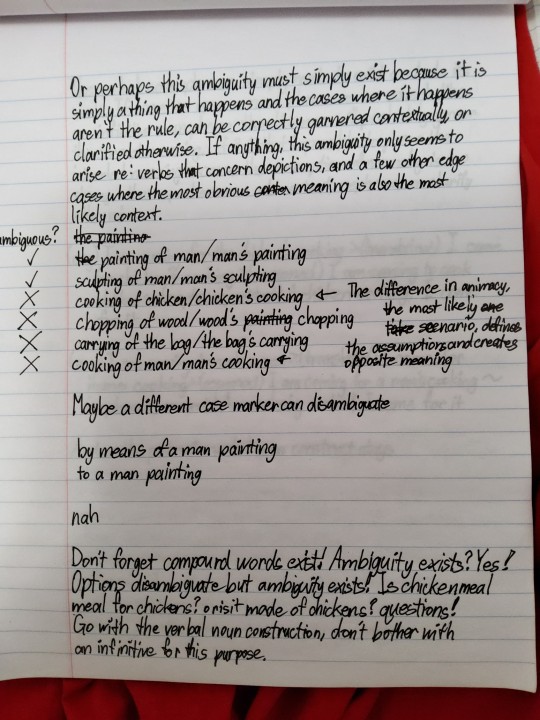
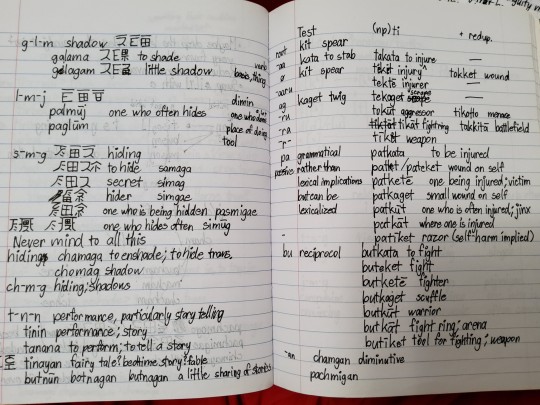


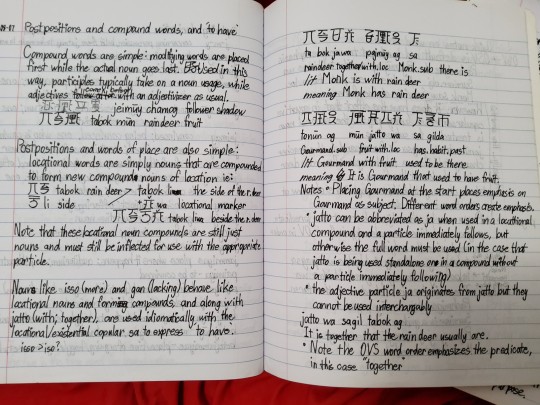
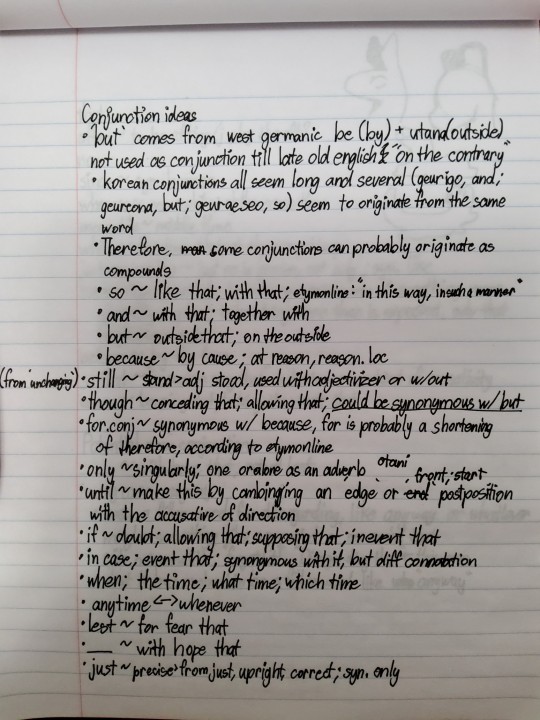

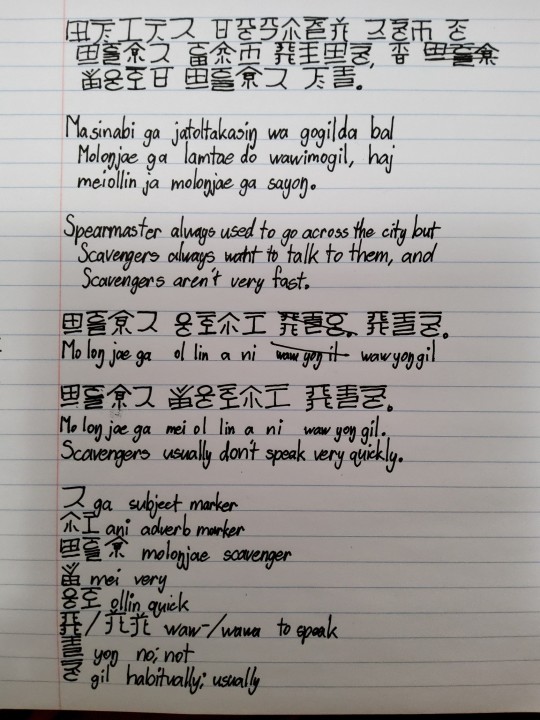
39 notes
·
View notes
Text
so I'm learning japanese for the bit. and how's it going? update: hilariously. I love it. everything is backwards. I am not bothering to learn any of the readings just recognise the kanji. the only materials I have are a book of short stories at b2 level and I cannot read a single kataKana. most of the hiragana I learnt about three years ago and then forgot to do any actual japanese since but I can read chinese so it's fine. I can read a surprising chunk of the book but don't know what any of the verb forms are outside the basics. did he pick up the sword? when will he pick up the sword? is he doubtign that he picked up the sword? may he have possibly (politely, in the past) once picked up the sword? and why does that servant seem to have such an impressive looking swor- oh he's a samurai. that's the character for samurai. I have installed a writing keyboard on my phone and it perfectly interprets my chinese squiggles and makes them into kanji with bizarre fae-like almost-but-not-quite meanings. I'm doing phonology from middle chinese on the fly. h>k got it got it. -ng > u?? well I still have to gather data on that one. please don't spell 'amerika' and 'kamera' in katakana @the history of the japanese script I Still Can't Read It pls just write it in kanji. pleease. some kanji are weirdly simplified to me and so look like the love-child of traditional and simplified chinese. postpositions my beloved and those are fine because my brain can already work backwards because of hindi but relative CLAUSES backwards??? now that's fun. now that's something to sink my teeth into. I'm not writing down any vocabulary. I'm looking up random grammar points online. basically it's going really well
#shitpost#japanese#langblr#japang...blr???#it's a process#chaotic but old-school#and it worked for german!! just read random shit and look random shit up#until you are literate much to everyone's surprise#here we go baby
46 notes
·
View notes
Text
Please don't string together a bunch of nonsense syllables for OC names.
Please don't string together a bunch of nonsense syllables for OC names.
The Earth and Fire Nation names in ATLA are drawn from the phonology of real East Asian languages and it's just phenomenally disrespectful. It makes it look like the writer thinks those languages are gobbledegook.
Quick guide:
For the Earth Kingdom, check out Mandarin phonology.
For the Fire Nation, names tend to be drawn from Japanese phonology. But the cultural inspirations for that region are drawn from all over East Asia, so you can also consider looking at Thai and Indonesian names, for example.
Please don't stick a bunch of z's in it and call it a day.
244 notes
·
View notes
Text
Furbish From a Linguistic Perspective
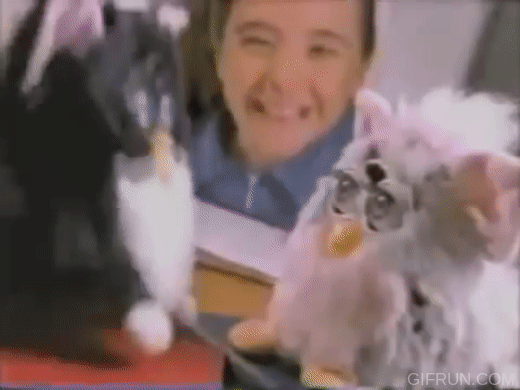
hi! if you're familiar with furbies you probably know the very short conlang (a sketch fictlang in particular) furbish! furbish is the language furbies speak before you "teach" them english by taking care of them. i will only be covering the '98 language, as the 2005 and 2010 language updates break some of the language rules the '98 version sets up, and I don't want to deal with that atm. also, do note i'm not a linguist, i just watch a lot of conlang critic
Phonology
Consonants
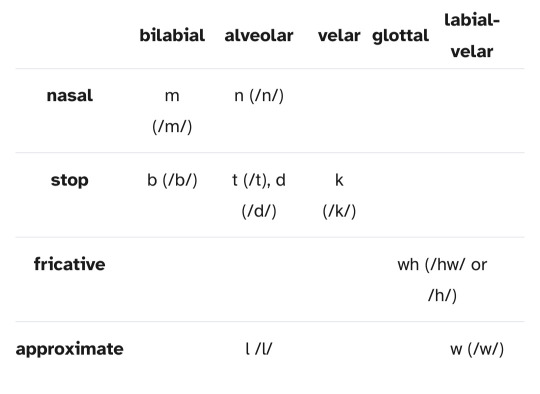
furbish has 9 consonants, with one digraph (wh) counting as a consonant for simplicity's sake. these consonants are /m/, /n/, /b/, /t/, /d/, /k/, /hw/ or /h/, /l/, and /w/.
Vowels
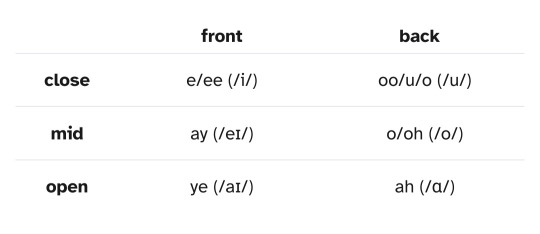
furbish has 6 vowels (including 2 dipthongs): /i/, /u/, /eɪ/, /o/, /aɪ/, and /ɑ/.
Syllables
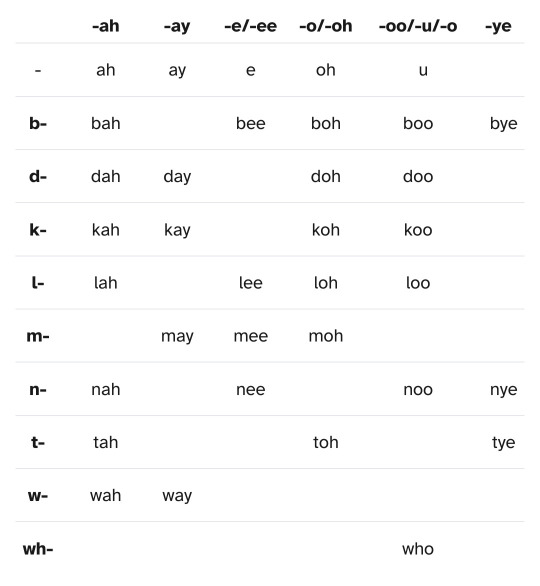
syllables are made up of vowels and consonants, shown in this chart. There are a total of 35 syllables in furbish.
Morphology
to make a word, syllables are put together using dashes, though some words are syllables on their own. additionally, new words can be created by putting a dash in between two existing words; like "ay-ay-lee-koo" (listen), a compound of "ay-ay" (look) and "lee-koo" (sound).
Grammar/Syntax
furbish seems to work almost the same as english grammar-wise, with a few differences. like many languages, it follows the subject–verb–object word order. for example, "i love you" would be "kah may-may u-nye". verbs have no conjugations and there are no tenses in furbish, along with there being no distinction between a singular and plural noun. most adjectives and nouns in furbish also work as verbs, and a word/phrase equivalent of "to be" does not exist. verbs have no conjugation, and adverbs go in front of the verb. it has two final particles, "doo" as a way to express that a question is being asked (similar to "ka" in japanese) and "wah" as a way to express excitement.
Proposals (Non-Canon)
i have a few proposals to make furbish a fuller language. for starters, making more syllable combinations for coining new words. secondly, a furby alphabet. each letter would represent a furbish syllable. another thing is filler words. i believe "ah" would be a great filler word, as furbies tend to say it a lot while being played with. i also suggest "doo", which could work as the furbish speaker questioning what they should say. finally, i've come up with a canon name for furbish in furbish. "kah-lee-koo", a compound of "kah" (me) and "lee-koo" (sound). roughly translated it means "my sound".

I'm autistic about furbies and conlangs fascinate me, so I had to make this!! I hope you all enjoyed :]
#furby#furbish#conlang#linguistics#conlanging#furby fandom#vurr.txt#autism off the charts#i wrote this a while ago but am JUST posting it now
300 notes
·
View notes
Note
Random question:
So a while back I read something where someone was talking about how if English spelling were reformed so every sound had a unique symbol that we’d lose the “visual alliteration” of Cape Cod.
I cannot figure out what that means. Are those /k/ sounds not both [k]? The only difference I’ve been able to notice is a feeling of the airstream moving outward in “Cape” and inward in “Cod”, but I can’t tell if that’s due to vowel influence or what.
Let's back up. The "someone" who was talking about this was either (a) wrong, (b) uncooperatively pedantic, or (c) imagining a very specific, non-alphabetic spelling reform of English (e.g. spelling English with logographic or syllabic glyphs).
Assuming (b), the only way that English spelling could be reformed such that the C's in Cape Cod would be different is if the spelling reforming was as sensitive as a narrow IPA transcription. If that was the case, then there are some transcriptions of English that would transcribe the first as [kʰʲ] and the second as [kʰ]. This level is detail is phonologically important for some languages. English is not one of these. A sensible spelling reform would spell those the same, whether C (because all instances of [k] become C) or K (because all instances of [k] become K). A nonsensical spelling reform would actually spell aspirated and unaspirated voiceless stops different, but even then, these two would be the same, as they're both aspirated.
The airstream is the same for both (egressive). What you're feeling, I expect, is the very slight movement in tongue position as the initial [k], which is palatalized, moves backward to an unpalatalized position. The reason you feel this is the tongue doesn't have to do anything in between the onset of the first word and the onset of the second. The tongue gets in position for [e], and in this position you can pronounce [k] well enough, then with [p], your tongue doesn't have to do anything; the lips take care of it. This means your tongue body can remain in place. For "Cod", it moves back as the tongue prepares to pronounce [ɑ] (or whatever back vowel you have there). Notice also that the tongue body has to go down, the tongue tip retracting slightly to pronounce [ɑ]. That's all part of it.
Now, assuming (c), yeah, that's indeed going to happen. Consider Japanese katakana. This is how "Cape Cod" is spelled: ケープコッド /keːpu koddo/. The relevant characters—the ones that begin each syllable—are ケ /ke/ and コ /ko/. And, yeah, they're different, so you do lose the visual alliteration. However, what you lose in visual similarity you gain in economy. To write /ka, ke, ki, ko, ku/ in an alphabet you need 6 different letter forms and 10 total glyphs. To write the same thing in katakana you need 5 different letter forms and 5 total glyphs. Consider an old style text message, which had a hard character count. A syllabary allows you to fit more letters in than an alphabet because each character encodes more information. When it comes to sheer character count, then, the Japanese writing system is much more efficient when it comes to writing Japanese than the English Romanization is.
Of course, that's for Japanese. For English it doesn't make as much sense because of our overabundance of consonant clusters. Typing lava in an alphabet takes 4 characters; in a syllabary, it takes 2. Typing straps, though, requires 6 characters in an alphabet and 5 in a syllabary. That doesn't save you a lot space—and a syllabary like Japanese's throws in extra vowels that have to be there, even if they're not pronounced, destroying its efficiency by, essentially, adding extra noise to the signal. Returning to straps, you have 6 characters, and all elements are vocalized. In katakana, you'd have to do ストラプス /sutorapusu/. You save a character with ラ /ra/, but then you have a whole bunch of vowels you have to remember not to pronounce.
Long story short, if you were going to reform the English spelling system, I don't think a syllabary (or even an abugida) makes sense, and a logography would be quite a thing to drop on the unsuspecting populace, even if it would be more equitable. This is why I guessed that what you overheard wasn't (c) and was likely (b).
Anyway, that's my 2¢. Hope it helps.
#language#linguistics#orthography#spelling#English#Japanese#syllabary#logography#alphabet#spelling reform
71 notes
·
View notes
Text
Bestiaryposting Results: Choglaem
First, it seems that Tumblr's search function is flawed in such a way that just searching the tag doesn't actually get all of the results. So if you drew something for this round and it's not in this post, let me know and I'll put it in a reblog. Same applies to previous (and future) rounds.
Anyway, it's now time to look at the results for the Choglaem! Anyone who doesn't know what that means is encouraged to look at previous posts in this series, collected at https://maniculum.tumblr.com/bestiaryposting .
And here's the link to the entry people are working from:
Now, let's get into it. As before, these are presented roughly in the order that people posted them. (I'm going to go through the tag on Tumblr's regular search, then again on the alternate search method someone suggested, so any that only show up on the alternate source are going to be at the end.)

@embervoices (link to post here) decided to show that the Choglaem is bigger than all living things on the earth by... having it fight Godzilla. Perfect. Inspired. Love it. No notes.
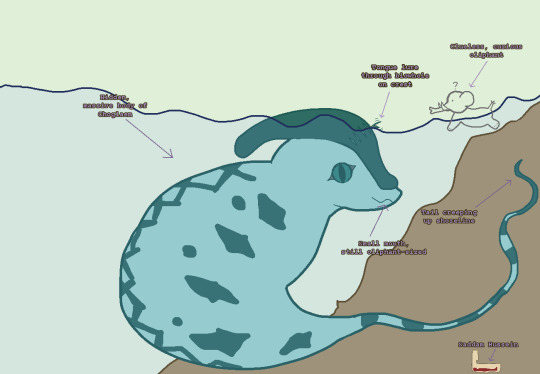
@mobileleprechaun (link to post) has helpfully labelled their drawing for us, which I enjoy. Also the interpretation that the tongue through the blowhole is a lure used by an underwater predator is a good one -- honestly, putting something this large in the water just feels more plausible, you know? In their tags, mobileleprechaun describes this as "sort of a dinosaur snake tsuchinoko", and I had to Google that last one, so let me show you the best result from that ...

(If anyone else needed that word defined, it's a creature from Japanese folklore that does actually look a lot like a fat snake, but I'm pretty sure it's not just a fat snake. There's a (disappointingly brief) Wikipedia article about it here: https://en.wikipedia.org/wiki/Tsuchinoko)
Anyway, the drawing is great! I have no idea why Saddam Hussein is there; you'll have to ask mobileleprechaun.
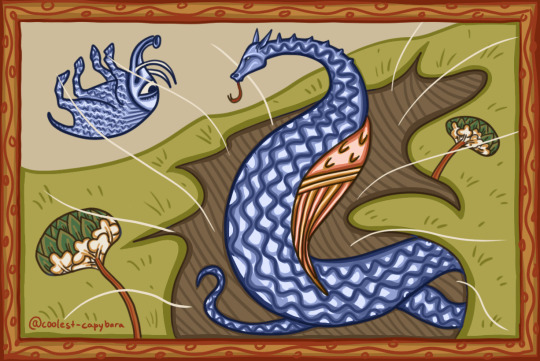
@coolest-capybara (link to post here) has given her Choglaem wings to aid in causing the air to become turbulent. The medieval stylization is pretty dead-on, I have to say; I swear I've seen those trees before. And I think this Choglaem may actually be the closest to the drawing in the Aberdeen Bestiary out of all the submissions we got, so coolest-capybara is clearly quite good at thinking like a medieval artist. The post linked above contains a brief explanation of her design choices and also a link to the medieval illustration that elephant is based on.

@silverhart-makes-art (link to post here) has once more done a very realistic-looking depiction of this week's beaſt. According to their post, part of their inspiration was an oarfish -- and I have to say this is pretty believable as a terrestrial version of an oarfish, so well done. I'm impressed by this one, which manages to look cool and dangerous but also kinda cute -- I think the tongue-through-the-blowhole part of the description makes all of them look a bit goofy in an endearing sort of way. The post linked above describes their design decisions, including a brief diversion over round pupils vs. slit pupils in snakes.
Silverhart also mentions that the nonsense-names I'm using sound like the names of mythical animals in a fantasy novel, so I feel I should confess what my process for randomly generating these names was. I've got a Goblin conlang that's been sitting in my pile of works-in-progress for years; I just fed the phonology from that into Zompist's gen program (link here), then picked out several dozen of my favorite results. So that's why they sound like kinda-plausible words.
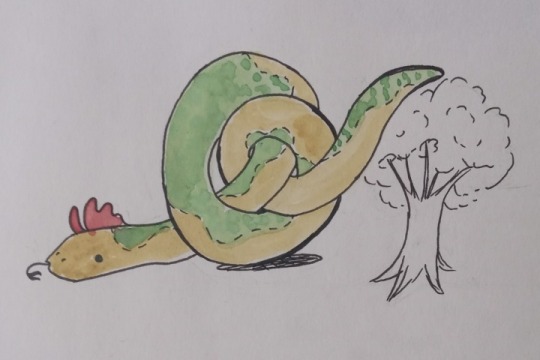
@sweetlyfez (link to post here) has drawn us a Choglaem who is having problems. Or, I don't know, maybe it meant to knot itself up like that; who am I to judge? Either way I think it's cute. Just look at that face. A brief overview of her design decisions is included in the linked post; I think the chicken crest is a pretty sensible call given the source material.
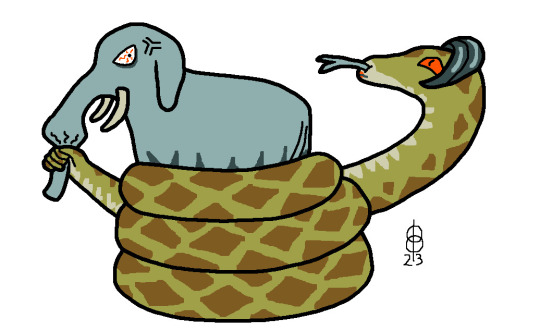
@pomrania (link to post here) has made some creative choices with their version. I like how they've decided that if the Choglaem kills with its tail, the tail should have something at the end rather than just... you know. A tail. That tracks. "The tail ends in a fist", specifically, however, was not something I saw coming. The crest looking like an emo hairstyle is funny, I think, and the angry elephant is great. The expression on the Choglaem's face is suspect to me; it looks like it's having too much fun with this. The linked post above includes an early draft, and itself links to a post with a detailed account of the artist's thought process and some additional sketches.
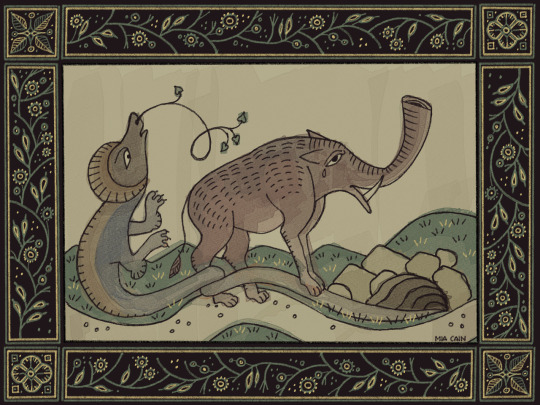
@miapcain (link to post here) has... wait, hold on, look at that border. That's gorgeous. Had to acknowledge that before moving to the inside of the frame. Anyway, Mia has given her Choglaem legs, which might seem odd for something described as a "snake", but actually isn't out of the ordinary for a medieval bestiary -- the authors tended to play a bit more fast and loose with their categorization of animals than we do today, and there are indeed examples of animals with legs being called "serpents" or "snakes". (I assume the artist knows this, I just want to share that with the rest of the audience.) Anyway, the drawing style is great; I like the stylized landscape and the muted colors. That elephant is definitely modeled after a medieval elephant -- I swear I've seen it before -- but I couldn't tell you which one offhand. Anyway. Love the vibes here. Not sure why the tongue is a vine, but it's a cool design feature.
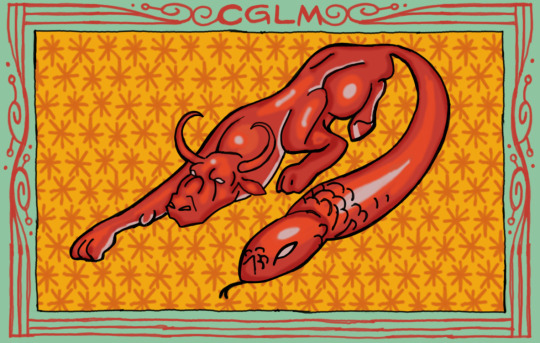
@rautavaara (link to post here) has gone an entirely different direction with this one, and I can kind of see the steps. Snakelike creature, kills with its tail... what if the tail it kills with is a snake. As a result, we have this chimeric "bovid-lion-snake beast", as the artist describes. It definitely stands out from the crowd, and looks menacing as hell. Rautavaara continues with the cool frames and stylization, and I continue to appreciate them. Kind of an art-deco feel on this one.
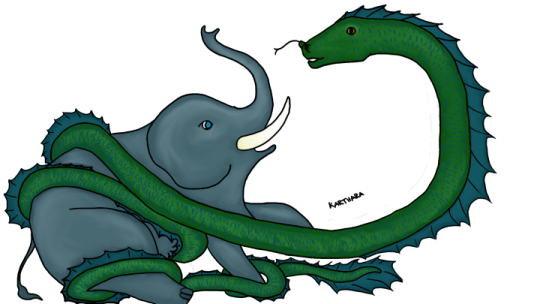
@karthara (link to post here) gives us a big snake with a somewhat aquatic-looking fin-crest, grappling with an elephant in a very believable manner. That is a quality depiction of a snake fighting an elephant, no mistake. And like I said before, a kind of aquatic look feels right for something this big. The linked post contains a short description of the design decisions.

@gradling (link to post here) apparently also had the thought of "if it kills with its tail there should be something dangerous on the tail", and made the excellent decision to give the Choglaem a thagomizer. That's amazing and I love it. The crest also looks quite good. I don't have anything else to add here. Thagomizer. Brilliant.
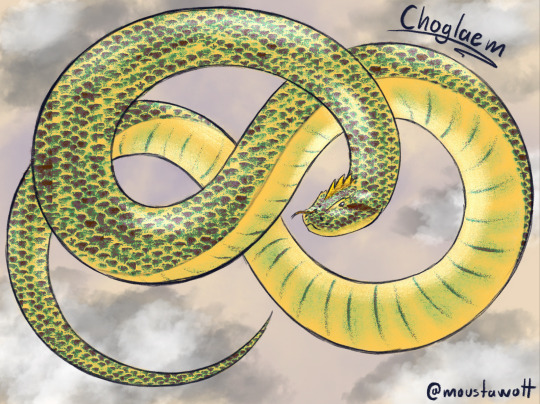
@moustawott (link to post here) has done this very cool, kind of celestial-looking Choglaem. I like that its pose is evoking an infinity symbol. And, of course, it is in its natural habitat:
the skies
A brief explanation of design choices can be found in the post linked above.
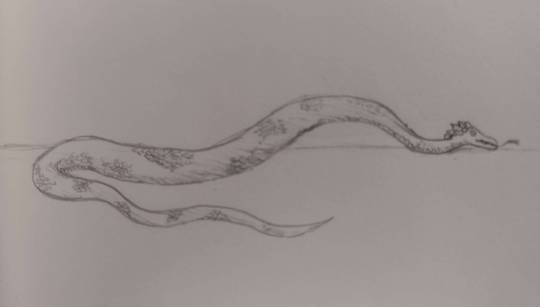
@treesurface (link to post here) has managed to really evoke the size of this thing even though it's the only thing on the page, which I think is quite good. Also, the brief discussion of their design choices in the post linked is pretty interesting, and honestly that's what I want to highlight for this piece, so go check that out.
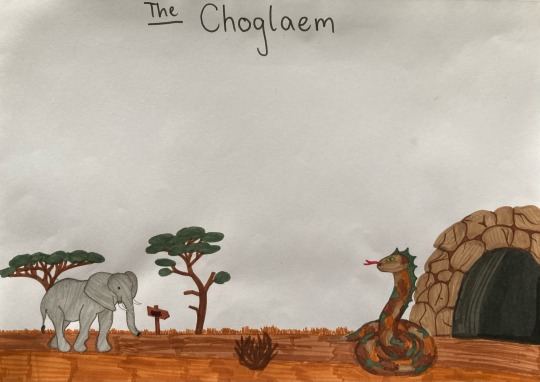
@scarlettbookworm (link to post here) has given us an elephant apparently in the moment when it realizes it's about to be attacked by a Choglaem. In order to allow their Choglaem to lurk despite its size, they've given it camo-pattern scales, which I think is clever. There's a pretty good explanation of their design choices in the linked post, which I think is worth reading.
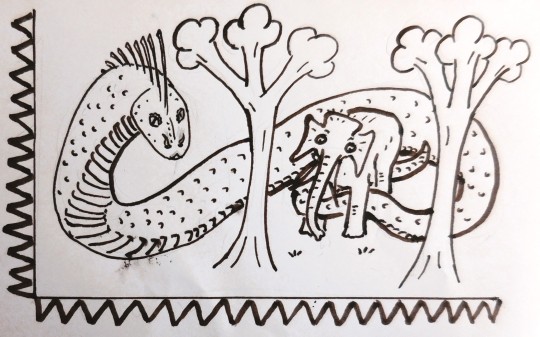
@cheapsweets (link to post here) apparently did this with a fountain pen, which I think is very cool. I like the oarfish-inspired crest, and the very menacing face, and the elephant being ambushed. However -- and I realize I've said this like three times in a row now -- you should check out the linked post to read the artist's explanation of their design decisions. They describe it pretty thoroughly and I think it's more worthwhile to read their account of what they've drawn than it is to read mine.
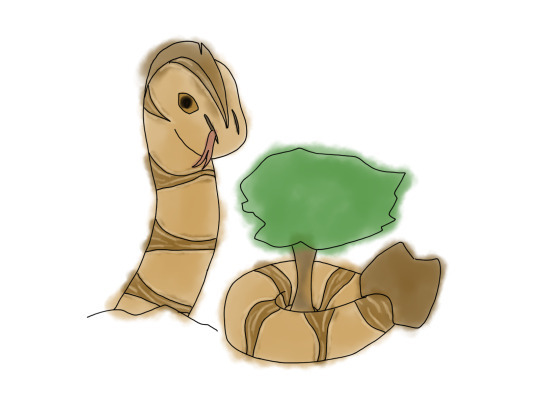
@strixcattus (link to post here) posted this while I was typing this round-up, so this will be the last result from Normal Tumblr Search. They've given us another "there should be something dangerous on the end of its tail" interpretation and drawn their Choglaem with an ankylosaur-style club, which I think is excellent. As per usual, their post includes an amazingly detailed modern-naturalist-style description of the animal in question, which I always enjoy. It's exactly my jam. (That bit about where the largest Choglaem lives... is that a reference to something? It feels familiar.)
All right, I'm now looking through "#choglaem" on @findtags's search system, and it is a bit different, oddly. There are fewer results than in the regular Tumblr search -- only six of the above images show up -- but it also has one that doesn't show up on the normal search! Dammit tumblr.
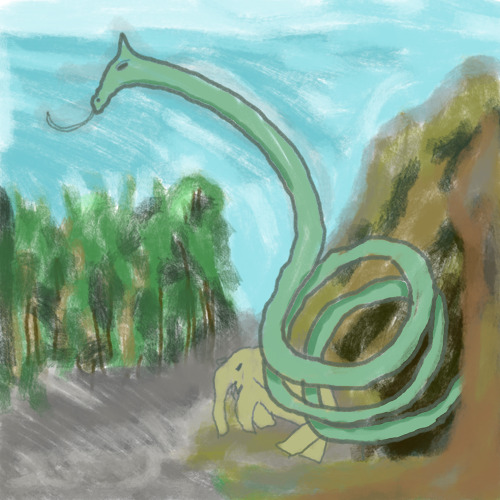
@hairycarrot ... whom Tumblr will not let me tag? what the hell? [edit: the tag works now that i’ve posted this, but the editor seemed to think this blog wasn’t real] um... (link to post here). Anyway, they've done this neat stylized thing that kind of looks like pastels? I don't know art, that's just what it looks like to me and I like it. I also enjoy the Choglaem being coiled up like a spring -- I know it's because it's a constrictor and showing it in coils is a good way to communicate that, but I still like the look. Very pleasant-looking depiction of an elephant being ambushed by a giant snake.
All right, time for the reveal. Here's the Aberdeen Bestiary drawing:
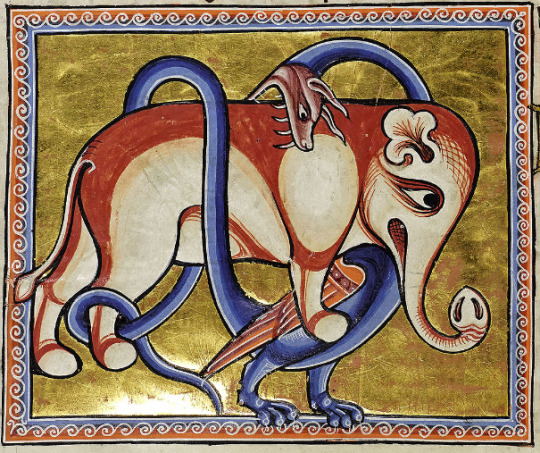
Yep. That snake has legs and wings. So everyone who added limbs was in an appropriately medieval mindset. It doesn't seem to have a crest, though, and I don't see any blowholes. And it's attacking with its bite more than with its tail. Honestly, I think y'all read the entry much more closely than this artist did.
But maybe they were also working with more preconceptions.
Because you see.
This is the entry for the Dragon.
Yeah, that's not what I was expecting from a bestiary description of a dragon either.
The interesting thing about it to me is that it's absolutely not what you generally see in fictional depictions of dragons in medieval literature. The bestiary entry is very firm on the idea that it's not venomous, it's a constrictor, it kills with its tail -- and most medieval dragons I've read about are highly venomous. Some of them aren't even that large; they're dangerous for their venom rather than their size. So maybe this is a bit of medieval mythbusting -- "no, guys, real dragons actually don't have venom at all".
And yes, this means there's historical precedent for the green & black dragons in D&D; dragons being so venomous they spit, breathe, or blow out poison instead of having to inject it with a bite is a pretty common motif in medieval dragon stories. I think a lot of people think of those as just variants on the classic fire-breathing version depicted by the red dragon, but actually there aren't that many fire-breathing dragons in medieval stories as far as I remember. (I would do some research on this, but I wanted to have this posted like two hours ago, so you're just getting what I remember off the top of my head instead of proper sources, sorry.) To my understanding, the classic fantasy dragon breathes fire because Smaug breathed fire. And Smaug breathed fire because the dragon in Beowulf breathed fire. But the Beowulf dragon isn't actually representative in that regard; the venom-spitting dragon is more common as far as I've seen. (No word on lightning or cold, sorry blue and white dragons.)
Anyway, there's probably room to reintroduce the constrictor dragon that kills with its tail. What colors haven't already been used up in the various monster manuals, splatbooks, &c.?
I'm rambling. End of post.
137 notes
·
View notes